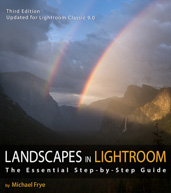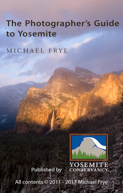In the Moment:
Michael Frye's Landscape Photography Blog
by Michael Frye | Jan 30, 2023 | Announcements
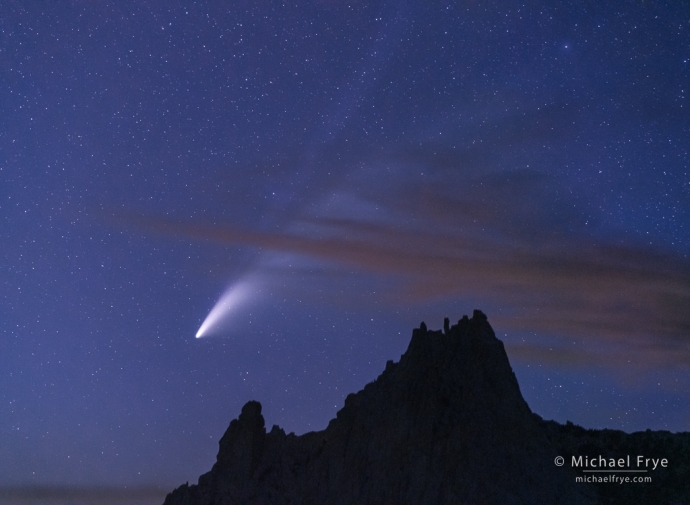
Comet NEOWISE over a Sierra peak, Yosemite NP, CA, USA
There’s still time to register for the Night Photo Summit next weekend, and for the Winter Speaker Series.
The Night Photo Summit online conference takes place February 3rd through 5th. I’ll be joining over 35 other distinguished instructors for this conference, including Albert Dros, Elia Locardi, Royce Bair, Rachel Jones Ross, Katrina Brown, Lance Keimig, Tim Cooper, Susan Magnano, Chris Nicholson, Kevin Adams, and many more. My presentation is about star-stacking – one of the best ways to reduce noise in nighttime photographs.
The first two editions of this conference have been really fun, and I’m looking forward to this weekend! You can learn more and sign up here:
Night Photo Summit, February 3-5, 2023
(more…)
by Michael Frye | Jan 26, 2023 | Light and Weather, Yosemite Photo Conditions
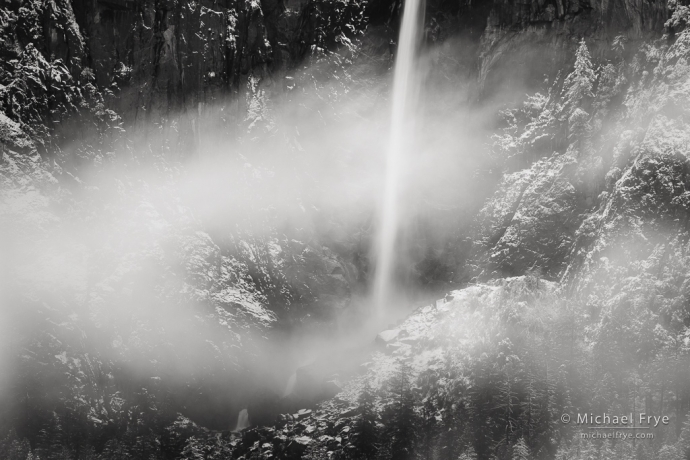
Mist, snow, and Bridalveil Fall, Yosemite NP, California
We had quite a series of storms in late December and early January. The Sierra foothills, where I live, didn’t suffer major flooding or mudslides, but there were lots of downed trees, power outages, and some washed-out roads.
Some nearby towns in the Central Valley, however, got some of the worst flooding in California. That includes Merced, which is about an hour’s drive from us, and Planada, a small town we regularly pass through on the way to Merced. The entire town of Planada was evacuated for two days earlier this month due to flooding.
(more…)
by Michael Frye | Jan 10, 2023 | Announcements
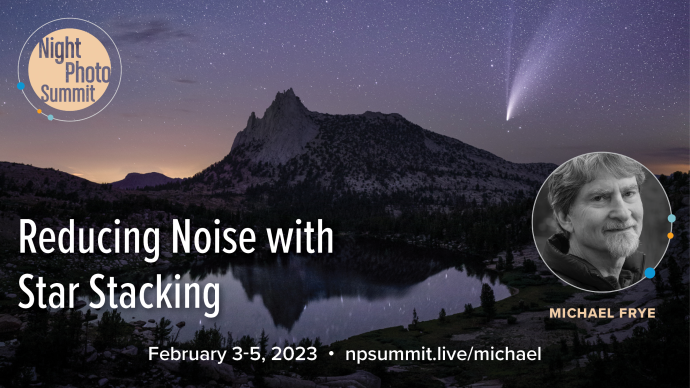
I’m happy to be joining the National Parks at Night team for the third annual Night Photo Summit next month!
This will be my third time presenting at the Night Photo Summit, and the previous two have been really fun, so I’m excited to be invited back! This online conference is devoted exclusively to night photography, and I’ll be joining over 35 other distinguished instructors, including Albert Dros, Elia Locardi, Royce Bair, Rachel Jones Ross, Katrina Brown, Lance Keimig, Tim Cooper, Susan Magnano, Chris Nicholson, Kevin Adams, and many more.
I’ll be presenting Reducing Noise With Star-Stacking. Star-stacking is one of the best ways to reduce noise in nighttime photographs. By blending multiple frames together you can average out random noise to create cleaner, sharper images – yet still make the stars points of light, rather than streaks. I’ll be covering the whole process from start to finish, from capturing the images in the field to blending them together later. And more importantly, you’ll learn how this technique can open up new creative avenues for nighttime photographs that wouldn’t be possible with single exposures.
(more…)
by Michael Frye | Jan 9, 2023 | Announcements
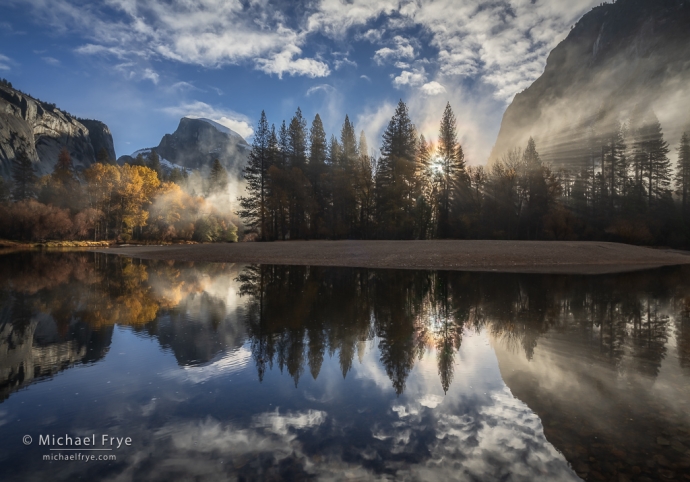
Sunbeams, mist, Half Dome, and the Merced River, Yosemite National Park, California
Just a reminder that next Monday I’ll be doing a presentation about Lightroom Masking for Nature Photography Classes as part of of their Winter Speaker Series. (That’s Monday, January 16th, at 4:00 p.m. Pacific Time.) This winter series also includes online presentations by David Kingham, Nick Page, and Sean Bagshaw – all focused on image processing.
You can sign up for these talks individually for $27 each, or register for all four speakers for $87 (which seems like a great bargain). And 10% of the proceeds go to individual charities chosen by the speaker (I’ve chosen the Yosemite Conservancy):
Click here to register for the Winter Speaker Series.
(more…)
by Michael Frye | Jan 5, 2023 | Announcements
The votes are all in and counted, and here are my top photographs of 2022!
We had a great response this year: 672 people looked through my initial selection of 42 images and voted for their favorites. That’s the second-highest total ever! (The most was 728 votes in 2016; I’ve been doing this every year since 2010.) A big thank you to everyone who took the time to look through these photographs and voice your opinions! I also really appreciate the kind words so many people posted in the comments or sent by email. I wish I could respond to everyone, but please know that I’ve read them all and am very grateful for all your support.
(more…)
by Michael Frye | Jan 4, 2023 | Announcements
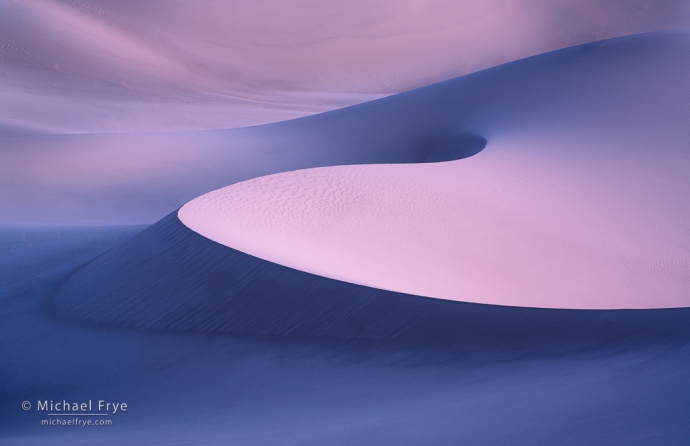
Curves at dusk, Death Valley NP, California
Just a reminder that this is the last day to cast your votes for my best photographs of 2022. You have until midnight! Again, please don’t send your votes to me by email, or post them in the comments, or they won’t be counted. Use the form at the end of the original post to cast your votes.
Click here to see the nominees and cast your vote.
The voting is closed! I’ll be posting the results soon.
Thanks to everyone who already voted! I appreciate your help. 🙂
— Michael Frye
(more…)
by Michael Frye | Dec 31, 2022 | Announcements
Once again I’m inviting you to help me choose my best photographs from the past year! I’ve posted 42 of my favorite images from 2022 below, in chronological order. After you look through these, please use the form at the bottom of this post to list your ten favorites.
Please don’t post your votes in the comments, or send them by email, because they won’t be counted! Use the form at the bottom of this post instead.
The voting is closed! I’ll be posting the results soon.
You don’t have to list your ten favorites in any order; just pick up to ten images. (The numbers are in the captions underneath the photographs. Also, you can click on the images to see them larger.) Once the votes are in I’ll post the top ten or twelve on this blog.
The voting deadline is Wednesday, January 4th, at midnight Pacific time.
As always, I reserve the right to override the votes if one of my favorites gets panned. But I’ve rarely had to exercise this power because my readers have excellent taste. 🙂
Thanks for your input — I appreciate your help!
(more…)
by Michael Frye | Dec 24, 2022 | Announcements
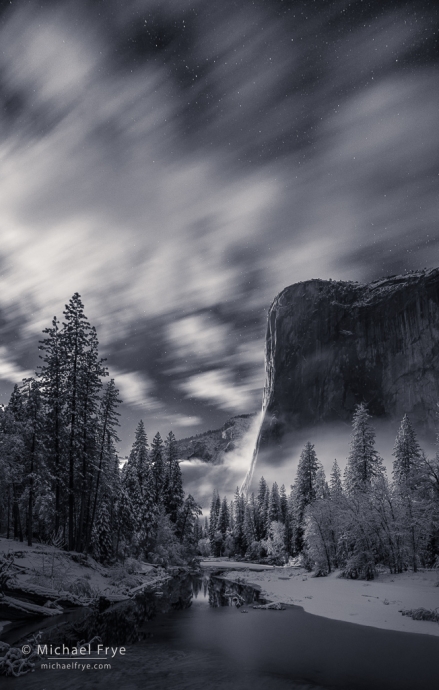
Moonlit clouds over El Capitan, Yosemite
While snow is rare at our house in the Sierra foothills, Yosemite Valley has received a few early-winter snowstorms, so Claudia and I have been able to go up there and enjoy the snow on several occasions, which is always a treat. To me, the holidays always feel more festive with snow. I made this photograph of El Capitan after one of those storms, as the setting moon lit El Capitan and the fast-moving clouds overhead.
For many people in North America, however, things probably seem a bit too wintry. It’s one thing to watch snowflakes floating gently to the ground outside while you sit around a cozy fire; it’s another to endure blizzard conditions, whiteouts, sub-zero temperatures, flight delays, and power outages.
Claudia and I hope everyone is able to stay safe, and warm, and to spend time with their loved ones (at least eventually) during this holiday season. Whatever the circumstances, we hope you’re able to make the best of things, and wish you a very Merry Christmas and Happy Hanukkah.
— Michael Frye
by Michael Frye | Dec 21, 2022 | Light and Weather
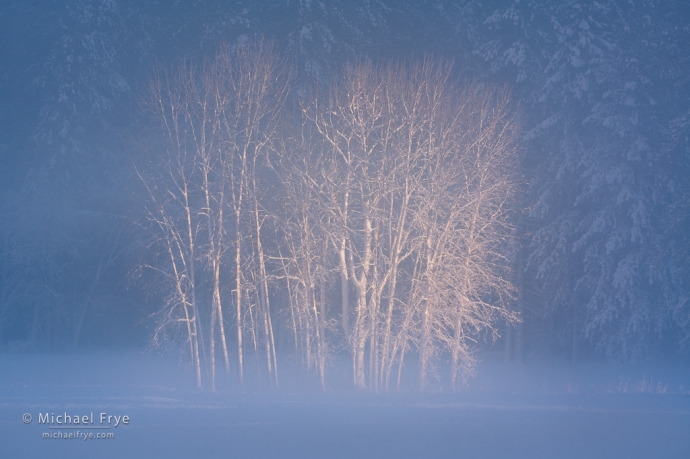
Cottonwoods in late-afternoon light, Yosemite NP, California
We’ve had a great start to the winter here in the Sierra, with several early-December storms bringing rain and higher-elevation snow. Precipitation is above average for Yosemite Valley at this point, which is wonderful. Some other recent winters have also gotten off to a strong start only to fizzle in January and February, so we’ll keep our fingers crossed that this winter will be different.
This winter’s early-season storms have been on the cold side, cold enough to bring snow to Yosemite Valley several times. The most recent storm (December 10th and 11th) followed a typical pattern, starting with rain in Yosemite Valley (at 4,000 feet), then changing to snow toward the end of the system as the cold front moved through. That tail end was pretty strong, dumping about eight to nine inches of new snow on the valley floor.
(more…)
by Michael Frye | Dec 18, 2022 | Announcements, Digital Darkroom
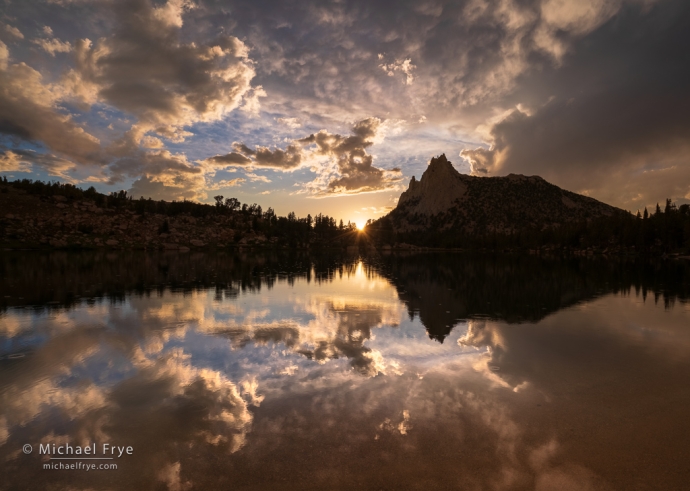
Sun setting over an alpine lake, Yosemite
I’m pleased to be joining the Winter Speaker Series on Nic Stover’s Nature Photography Classes site. The Winter Speaker Series will be focused on image processing, and includes online presentations by David Kingham, Nick Page, Sean Bagshaw, and me.
My talk will be about the Masking Panel and local adjustments in Lightroom Classic. The Masking Panel is incredibly powerful, allowing you make and combine selections in almost infinite ways, and add sophisticated touches to your images that you previously needed Photoshop for.
(more…)















